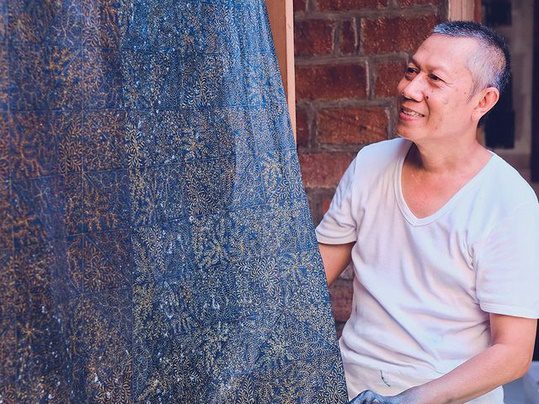Is it possible to produce batik sustainably? The answer is YES!
Showing the way for sustainable batik production is Zahir Widadi, renowned batik artist, Dean of the Batik Faculty at the University of Pekalongan, and the former Director of the Batik Museum in Pekalongan.
Zahir stumbled upon rows of Indigofera plants wildly growing in and around the bushes along the west side of the North Coast of Java many years ago. This was how his lifetime affair with Indigo and natural-dyed batik started.
Zahir Widadi believes that indigo solution is best to be kept 100% natural, containing only all-natural ingredients. Zahir created his Indigo-dyed batik with natural malam (wax), made of the sap from a pine tree, a resin from dammar gum, and beeswax; coconut sugar reducing agent, and tapioca starch solution.
“Since the indigo solution in itself is already a natural dye, I think it would be unfortunate to mix it with chemicals as reduction agents. I believe it would be best to have a piece of batik cloth that is made with an all-natural dye—without any synthetic materials like hydro-sulfite or caustic soda—especially because there are some plant-based natural reducing agents we can work with,” said Zahir.
Indeed, it takes more time to create an Indigo solution with a natural reducing agent. It will take more or less 12 hours to a few days to get your all-natural indigo solution ready, while you can get a solution ready in only 3-5 minutes with synthetic reducing agents. The overall cost of using a natural reducing agent is also much higher.
However, an indigo solution that is made from all-natural ingredients can last months or even years longer than the solutions mixed with synthetic chemicals or other non-natural ingredients. The solution of the latter type can deteriorate quickly and must be used up immediately.

Zahir believes that to preserve the wisdom of Indonesian natural-dyed batik, everyone needs to start paying attention to a sustainable ecosystem for Indonesian batik, from top to bottom. “It’s not only about batik designers or artists, but also the plants and the environment, the water sources, the farmers, the batik workers, the maker of canting and batik stamps, the fabric industry, the documentation and research about Indonesian batik, and many more. Plus, don’t forget about batik students: who will preserve our batik culture for generations to come. There are so many things we can do about this issue. Now, I am doing my part.”





